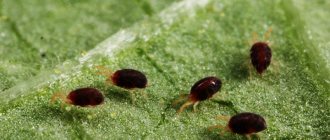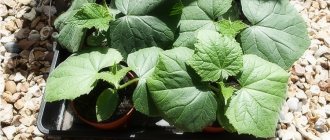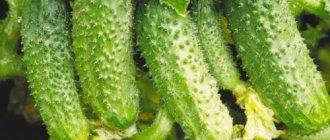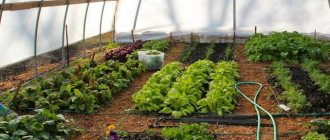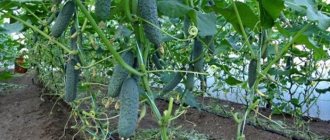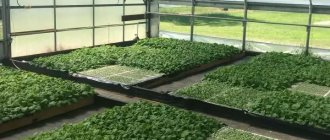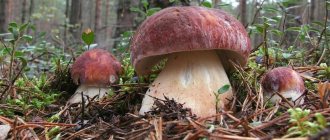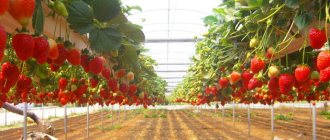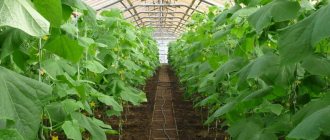Growing a good harvest of vegetables is the dream of any summer resident. One of the gardener's favorite crops is cucumbers. Tropical India is considered the birthplace of this vegetable. Therefore, cucumbers love warmth; cold weather is unfavorable for their growth.
It is easier to get a large harvest of cucumbers in a greenhouse than in open ground. The climate in modern greenhouses corresponds to the natural one - high humidity and temperature are favorable for the growth of heat-loving crops.
Features of growing in greenhouse conditions
Growing cucumbers indoors has its own characteristics:
- the possibility of cultivating long salad cucumbers that are not suitable for open ground;
- carefully monitor the quality of the soil, since in a limited area the amount of nutrients is quickly consumed by plants;
- annual soil replacement or planting catch crops after cucumbers to prevent the development of diseases;
- obtaining a harvest at any time of the year, regardless of the climate;
- with the vertical growing method, the color of the fruit is uniform;
- absence of the likelihood of mechanical damage and the influence of weather conditions on the growing season of cucumbers.
How to grow beautiful fruits?
Even their final shape depends on how competently the process of growing cucumbers in a greenhouse took place. Thus, ugly fruits of a strange shape always indicate that the plant lacked some important substances, or the growing conditions were created incorrectly:
- If there is a temperature difference or a sudden illness, a normal ovary will not form - only those ovules near the stigma will be fertilized. As a result, the flower part of the fruit will grow, but the part near the stalk remains underdeveloped. And the same picture can be seen with late pollination.
- But the underdeveloped upper part of the fruit indicates a lack of nutrition and untimely harvesting.
- If your cucumbers turn out to look like a pear, then they urgently need to be fed with wood ash or any other potash fertilizer.
- Ball-shaped fruits with a narrowed end are obtained when the plant lacks nitrogen.
- If the cucumbers are constricted and somehow twisted, the greenhouse is too hot, but there is not enough moisture.
- But with a lack of phosphorus, the leaves become smaller and become dark green. Plant growth also slows down. It is the darkening of the tips of the leaves that indicates a lack of copper.
Necessary equipment
To grow cucumbers indoors, two conditions are important: a suitable greenhouse and its equipment. When choosing a shelter, please note that polycarbonate greenhouses have more advantages than those based on film or frame. They are easy to transport, rearrange and assemble, wear-resistant, have minimal influence of weather conditions, and are more airtight.
The size of the shelter must be at least 10 square meters. m, and the height is about 2 m. It is not recommended to build a higher greenhouse, since maintaining the microclimate in it will be problematic due to the large layer of air. But a lower height when growing cucumbers is also unacceptable. This is due to the fact that cucumber vines, if placed vertically, will not have enough space; their length can exceed 3.5 m.
The choice of location for installing the greenhouse is of great importance. It should be a flat surface or a small hill so that groundwater does not flood it and cause mold to appear.
The greenhouse should be installed in a north-south direction to optimize the receipt of natural sunlight and heat.
Cucumber varieties suitable for greenhouses
Not all cucumbers can be grown indoors. The problem is the lack of access to bees and other insects that can pollinate the flowers. Therefore, breeders have developed special varieties that do not require pollination.
- Self-pollinating varieties are distinguished by the fact that they have a pistil and a stamen in one flower. Pollination occurs without outside participation.
- Parthenocarpic cucumbers are capable of producing only female flowers. They do not need pollination, but their fruits do not have seeds. For subsequent cultivation of such cucumbers, it is necessary to purchase seeds from breeders each time.
Greenhouse preparation
After choosing a location and installing the shelter, preparatory work should be carried out. They consist of the following activities:
- Inspecting the greenhouse for cracks and eliminating them. This will protect the cucumbers from the negative effects of drafts.
- Be sure to treat the inside of the shelter with an antifungal compound to avoid contamination of the soil and seedlings.
- Consider the location of the beds and choose the method of their formation. Most often, longitudinal rows are placed along the shelter. Their width is approximately 50 cm, and the passage must be left at least 90 cm. If the size of the shelter allows, you can use a location method that involves building a shortened bed in the middle with a circular passage and 2 rows along the length of the sides of the greenhouse.
- Cucumbers are a heat-loving crop, so depending on your plans for growing them, you may need to organize a heated floor under the beds to warm the soil when growing cucumbers year-round.
- It is advisable to install containers with water in the shelter, which will perform 2 functions: warming up during the day, giving off heat at night and being a source for irrigation with warm water.
- Provide a ventilation system. These could be additional windows or an automatic ventilation system. Moreover, the location of the vents on the roof and along the walls under the ceiling makes it possible to ventilate the room without drying out the soil, as happens when opening a door and a vent on the opposite wall.
Types of greenhouses for cucumbers
Those who decide to set up a greenhouse on their site have two options - assemble it themselves, or purchase a ready-made one. In both cases, there are a number of features. Read what greenhouses and greenhouses for cucumbers exist here.
The initial investment boils down to the purchase of materials for building a greenhouse
If the greenhouse is purchased, there is no need to think about the choice of material and design. This greenhouse will be delivered and installed by specialists. The disadvantage of such a greenhouse is its high cost and standard parameters, which may not be suitable for a particular site. A self-assembled structure is modeled to the required dimensions and is easier to disassemble. However, you need to spend your time and effort collecting it.
- A film greenhouse is usually assembled independently. Such a greenhouse is assembled from arcs, which are covered with film. Polyethylene is pressed to the ground using stones or boards. Caring for such a greenhouse is simple. You just need to lift the film and you can water and ventilate.
- The butterfly greenhouse is a convenient design that helps to distribute space on the site as profitably as possible. It is a box that looks like a small house with a semicircular roof. Both sides of the greenhouse open and provide access to the interior. There are both ready-made greenhouses sold in stores and those assembled with your own hands.
The butterfly greenhouse takes up little space, which is its advantage
- Polycarbonate greenhouses have a transparency of about 80%, are not subject to deformation during hail or snow, and also release heat slowly.
- A winter greenhouse is the most labor-intensive to build. However, only it allows you to harvest cucumbers during the winter cold. Such a structure must be completely sealed, there must be light and warmth. These greenhouses are either racked (cucumbers are planted on shelves) or non-racked (planted in the ground). Previously, such greenhouses were almost all glass. Nowadays most of them are constructed from polycarbonate.
Choosing the right variety
Growing cucumbers indoors means that pollinating insects will not have access to the plant's flower stalks. Therefore, for this case, choose varieties that can self-pollinate or those that do not need pollination at all - parthenocarpic. These properties are indicated on the seed package.
It is important to distinguish cucumber varieties from their hybrids. When planting varietal types of vegetables, their properties will be repeated from year to year, and it is possible to obtain your own seeds from the most successful harvest.
When using hybrids, self-collected cucumber seeds do not carry the properties and qualities of the previous harvest. This means that hybrid seed must be purchased annually.
Let's consider some varieties and hybrids suitable for growing in shelter:
- Adam F1. A hybrid from Holland with the ability to self-pollinate and obtain a rich, early-ripening harvest. The first vegetables can be harvested after 1.5 months, and the fruiting period is quite long. Under favorable conditions, cucumbers are tied in 5-7 pieces. in one node. The fruits are small in size, dark in color with small spines. Suitable for preparation and fresh consumption.
- Herman F1. A wonderful hybrid of Dutch selection. Very early, with a long fruiting period. Small cucumbers develop in bunches of 6-7 pieces. The fruits are juicy and dense. The hybrid is resistant to temperature changes and diseases. Good fresh and canned. Planting in open ground and greenhouses is possible.
- Son-in-law F1. Parthenocarpic hybrid. Fruits develop in nodes of 3-7 pieces. up to 10 cm long. Can be harvested at any stage of maturity. Cucumbers are delicious, yield up to 6 kg per plant. Resistant to powdery mildew and root rot. Adaptable to sudden changes in weather conditions.
In addition to the presented species, it is possible to sow seeds of the following cucumber varieties: “Metelitsa”, “Prestige”, “Ararat”, “Tatyana”, “Fed Papa”, “Everyone is Envy”, etc.
Choosing a greenhouse
Greenhouses differ from greenhouses primarily in their height, so their design should be thought out in such a way that it is convenient to care for the plants .
The design of greenhouses for cucumbers can be square or rectangular, and the height can be low or medium height.
The upper part of the greenhouse can be single-slope, gable, or broken. The most convenient design is one in which it is possible to open the roof .
The base for greenhouses is made of metal or wood. Greenhouses based on metal wire placed at a shallow depth in the ground are popular.
Polyethylene film and non-woven covering material are used as covering.
The main condition for choosing a covering for a greenhouse is light transmittance . Cucumbers need sufficient light to ripen.
At the same time, the material must be dense enough to protect heat-loving plants from wind and drafts. Protection from morning, cold dew is also very important for this vegetable.
You can see other greenhouses that you can also assemble or make with your own hands here: From plastic bottles, From PVC, From arcs, From polycarbonate, From window frames, For seedlings, From profile pipes, Under film, For the dacha, For peppers, Winter greenhouse , Beautiful cottage, Successful harvest, Snowdrop, Snail, Dayas
Soil preparation
For sowing cucumber seeds, it is preferable to use peat pots rather than reusable containers. This is due to the fact that the crop does not like replanting when its root system is disturbed.
Soil for filling seed containers can be purchased in specialized stores and departments. This soil mixture will be disinfected and has a special composition suitable specifically for growing cucumbers.
The second option for obtaining soil for planting seeds is to prepare it yourself. To do this, take the following ingredients and mix them thoroughly:
- turf - 1 part;
- compost - 2 parts;
- peat - 1 part;
- sand - 1 part.
Such a soil mixture should be subjected to a disinfection procedure before use. To do this, you can use one of the options:
- heat it in the oven at a temperature of 170-180 degrees for 20 minutes;
- process in a special steam generator for half an hour;
- dilute 15 ml of Fitosporin in 10 liters of water and pour over the soil.
After processing, it is necessary to add fertilizer to the planting mixture to enrich it with nutrients and elements. For 10 kg of soil add:
- wood ash - 200 g;
- phosphorus fertilizers - 50 g;
- potassium sulphide - 35 g.
After thoroughly mixing the mixture, it must be moistened. High-quality soil is ready for sowing cucumber seeds.
Landing
Seeds or seedlings
For a greenhouse, both methods are chosen. If the seedling method of planting cucumbers is chosen, then the soil in the prepared soil needs to warm up to at least 15 °C. The holes are pre-disinfected and watered. The same is done with the seed method, but in this case the harvest is obtained much later.
Cucumber seedlings should be stored under film until the first leaves sprout.
Properly preparing seeds for sowing
Seed material purchased in factory packaging does not require additional preparation. If the seeds are collected independently or purchased in another way, then the following preparatory procedures must be carried out:
- Selection. From the total mass, select the largest and most identical in shape. Prepare a saline solution from 1 tsp. salt and a glass of water. Dip the selected seeds into it. Remove those that remain on the surface. The rest - rinse with clean water and dry until flowability is restored.
- Disinfection. Prepare a slightly pink solution of manganese and dip cucumber seeds in it for 15-20 minutes. You should not make a more concentrated solution or keep the seeds in it for longer than the prescribed time. This will lead to burns of the seed and render it unusable.
Instead of manganese solution, you can use Fitosporin-M or Gamair-SP.
After processing, rinse the seeds with running water and dry.
- Impact of temperature. To speed up germination, place the seeds in a bag and warm them near a heating device. The reverse method is also good - place the seeds in the refrigerator for a day.
- Germination. Line a shallow plate with several layers of gauze. Distribute cucumber seeds over its surface and moisten well. Cover the top with a wet cloth. Make sure that the lower and upper material does not dry out.
Growing cucumbers in a polycarbonate greenhouse
Even those who have never been involved in vegetable growing before, having studied its basic aspects, are able to achieve success. But planting and caring for cucumbers in a greenhouse requires certain labor costs. First you need to build a shelter, which needs to be taken care of in advance, and prepare the beds. Polycarbonate greenhouses are the optimal solution; cucumbers grow and bear fruit well in such closed ground. Purchasing high-quality planting material is also an important stage of preparation. It is recommended to choose seeds of crops that are suitable for growing in the region, do not require pollination by insects, can withstand unfavorable climatic conditions (drought, cold spells and frosts) and are immune to the most common diseases. You should also pay attention to the timing of fruit ripening. Cucumbers can begin to bear fruit a month or two after germination. It is best to plant plants with different characteristics in a greenhouse. This approach will help produce crops over a long period of time.
Depending on your preferences, climate and capabilities, you choose the method of planting cucumbers.
How to plant cucumbers with seeds correctly
Seeds can be planted directly in the greenhouse (this method is usually practiced in the southern regions). However, you should do a little preparation beforehand.
First, the seed material is checked for germination, for which it is placed in a container with a saline solution. The floating seeds can be thrown away; nothing will grow from them. After this procedure, disinfection should be carried out. This operation is especially indicated if you use your own planting material, since producers most often carry out disinfection. For processing, you need to prepare a solution of potassium permanganate, in which the seeds are kept for about half an hour.
Experienced gardeners also use a little trick - bubbling. The procedure consists of placing the seeds in water for a day, into which air is supplied (for example, with a hose connected to an aquarium compressor). This measure allows you to saturate the seeds with oxygen, which improves their germination.
Soaking seeds for several hours (the exact time is indicated in the instructions for the specific product) in a growth stimulator accelerates their germination. Today, manufacturers offer a sufficient range of such compounds; Epin and Zircon are in great demand.
To treat seeds, you can also use natural growth stimulants, such as aloe juice or honey.
You can start planting seeds, but pre-germination guarantees early germination. Otherwise, it is possible that after some time it will be necessary to re-sow. The easiest way to germinate cucumbers is in wet gauze, folded in several layers, or in fabric made from natural fibers. The seeds remain in the material, which will have to be periodically moistened, for several days. After about a week (sometimes grains germinate in 2 days), small sprouts should appear. You can also use wet sawdust for germination, covering the container with polyethylene.
Seeds with sprouts that have appeared can be planted in closed ground.
Recommendations for planting seedlings
Pre-growing seedlings helps to get an earlier harvest and save planting material. Its preparation is carried out in the same way as described above.
It is recommended to plant sprouted seeds one at a time (maximum two) in a separate container with a volume of 300...500 ml. Soil for seedlings can be used purchased (for growing vegetables) or you can mix it yourself from peat, humus, turf soil (in equal quantities) and sawdust (half as much as the main ingredients). It is recommended to disinfect the soil either in the oven, or with boiling water, or with a solution of potassium permanganate. You can also purchase peat cups or tablets for seedlings.
Seeds are placed in a container with soil (at an angle, the spout should be on top). Having sprinkled them with earth (a layer of about 15 mm), it is necessary to water the future seedlings. Until the sprouts appear, the seedlings should be covered with film.
Caring for seedlings is not difficult: they need to be watered and fertilized. Plants will need nutrition two weeks after germination.
Growing seedlings
After selecting the container, preparing the soil and seeds, you can begin directly planting the seed material for seedlings. To do this, follow the work algorithm:
- Place a drainage layer on the bottom of the peat pots and fill 3/4 of the pot with prepared soil on top. Place the container in the tray and moisten.
- Make a hole in the middle of the pot, about 1cm deep, and place a couple of seeds in it. Cover them with soil, slightly compacting it.
- Using a sprayer, moisten the soil surface with water and cover with glass or plastic film.
- Transfer the pots to a sunny windowsill or other place with a temperature range of 25-28 degrees.
Remove glass or film daily, moistening and ventilating the crops. This will prevent mold from appearing on the surface of the soil.
Moisten the soil not by watering, but by spraying water using a spray bottle.
Correct temperature conditions are important for seed germination. Shoots appear after 5-6 days at a temperature of 27-28 degrees. When leaves appear, you should adhere to a daytime temperature of 19-22 °C, and at night - 15-17 °C.
When the first leaf forms on the seedlings, fertilize with a solution of complex fertilizer.
Make sure that the plants do not stretch towards the light source. To do this, rotate the containers periodically. As the plants grow, move them away from each other so that the shadow created does not interfere with their quality development.
How and when to plant cucumber seedlings is described in more detail here.
What problems do gardeners face?
Greenhouse owners, especially those who grow cucumbers for the first time, are not immune from mistakes that lead to deterioration of the growing season of the crop and a decrease in yield.
Common mistakes when planting seeds and transplanting seedlings
Sometimes the time and effort spent on growing plants does not bring the expected results.
Why gardeners cannot grow seedlings or subsequently get a high yield of vegetables:
- Due to poor preparation of seed material, plants become weak and sickly.
- Early planting of seeds leads to the fact that by the time the cucumbers are transferred to the greenhouse, they become too elongated. Such weakened seedlings do not take root well and may even die.
- If you plant seeds too deep in containers with soil, they may not sprout. The thickness of the layer of earth above them should not be more than 20 mm.
- When planting seeds not in individual containers, but in a common container, the sprouts that appear are often too thick and cannot develop normally. It is necessary to maintain a distance between plants within 40...50 mm.
- A lack of sunlight becomes one of the reasons for excessive stretching of seedlings. For normal development, it requires light for at least 12 hours a day.
- Cold slows down the growth of seedlings, and too high an air temperature also leads to elongation of sprouts. Optimal values for growing cucumbers: +20…+25 degrees.
Plants also need moderate watering, fertilization, and timely picking. If you don’t do this, you won’t be able to grow strong seedlings. However, even having received healthy and well-developed seedlings, without proper care for them in a greenhouse, you cannot expect a decent harvest.
Preparing soil in a greenhouse
Cucumbers grow well on loose and fertile soil, which retains moisture and is breathable. This is why fruits cannot be obtained on clay or sandy soils. The former are not able to allow the necessary air to pass inside, and the latter soils dry out too quickly, conducting water into deeper layers.
Things to consider:
- If the predecessors of cucumbers in the greenhouse were melons or pumpkins, then it is better to replace the soil with a new one, because it is depleted in nutrition and there is a high probability of common diseases and pests. It is advisable to plant cucumbers after cabbage, carrots, potatoes, onions, and peppers.
- It is necessary to prepare greenhouse beds in the fall. Remove all plant debris and dig up the soil, adding humus or compost 1 bucket per square meter. m. With this option, you can forget about organic fertilizing for 2-3 years, using only mineral fertilizers.
- Another solution to replenish nutrients when digging up beds in the fall is to distribute them per square meter. m of land 2 tbsp. l. superphosphate and 1 tbsp. dolomite flour (can be replaced with wood ash). In the spring, 2 weeks before planting seedlings, add peat, sawdust, humus to the soil, and dig shallowly again.
- To prevent cucumber diseases, be sure to treat the surface of the beds with a solution of copper sulfate. To prepare it, dissolve 1 tbsp in 10 liters of water. l. drug. Consumption rate - 1 liter per 1 sq. m.
- A good solution is to plant green manure in the fall, such as leaf mustard. Before frost, dig up the beds along with the plants. Over the winter they will undergo decomposition, enriching the soil with nutrition and disinfecting it.
An important nuance for growing cucumbers is warming up the soil. If there is a warm base of the beds, seedlings can be planted at any time of the year. If there is no such equipment in the greenhouse, then there are 2 solutions: wait for the soil to naturally warm up or insulate it with organic matter:
- To do this, remove the top soil layer to a depth of 15-20 cm, lay down straw, spread humus and compost on top, and fill the soil layer back.
- Spray the beds with hot water and cover with dark film. As organic matter decomposes, it releases not only nutrients, but also the heat the seedlings need. These events are carried out several days before planting the seedlings.
Soil quality and breathability
Always make sure that the soil for cucumbers in the greenhouse is loose and saturated with oxygen. The easiest way to achieve this is to add sawdust or finely chopped straw every spring, which must be prepared in the fall. But after this procedure, be sure to add nitrogen fertilizers, because it is known that sawdust and straw bind nitrogen into a form inaccessible to plants. By the way, crushed tree bark, humus and top peat are also well suited as loosening materials.
Here are the best soil recipes for a greenhouse with cucumbers:
- 1 part each of peat, humus, turf soil and sawdust.
- 6 parts peat with 2 parts humus and 2 parts sawdust.
- 2 parts turf type soil, 3 parts peat, 3 parts humus and 1 part sawdust.
- 5 parts turf type soil, 1 part peat and 1 part humus.
Make the beds 80 cm wide, 35 cm high and 60-70 cm wide. Before planting seedlings, spread fertilizer over the beds: 1 tbsp. a tablespoon of potassium sulfate + 1 teaspoon of urea + 1 tablespoon of superphosphate + 1 glass of ash.
As the cucumber grows, the roots of its plant are gradually exposed - cover them with moistened soil in time.
Transplanting
In greenhouses, without additional heating, plant seedlings no earlier than the end of May, when the soil temperature inside reaches 14-16 degrees, so that the weak roots do not freeze, but can adapt to new conditions. To measure the level of soil warming, lower the thermometer into the soil to a depth of 20 cm for 30 minutes in the morning.
Cucumbers can be planted in heated shelters as soon as 4 leaves have formed on the seedlings. This occurs approximately 35 days after sowing the seeds.
The most commonly used scheme for planting cucumbers in a greenhouse is:
- two rows of cucumbers are placed in a longitudinal bed;
- the distance between neighboring bushes in a row is maintained at 30-40 cm;
- seedlings in one bed, but in adjacent rows are planted in a parallel or staggered order, keeping a distance between them of at least 50 cm;
- the hole should be strictly under the trellis, or stretch a cucumber net between the rows.
Algorithm for planting seedlings in a greenhouse:
- Moisten the soil in the beds with hot water.
- Make holes and distribute peat pots with seedlings over them. The recess should be such that the upper edge of the container protrudes above the surface of the ground. Lightly compact the soil.
- Sprinkle a 2-centimeter layer of peat with sawdust on top, mulching the root part of the plants.
- Do not water the planted seedlings for 2 days.
Watch a video about planting cucumber seedlings in a greenhouse:
Humidity and ventilation
Because The genotype of the cucumber was formed over centuries in the humid subtropics; the leaves and roots of this plant do not know how to draw moisture from dried soil, and do not know how to store it in a dry environment. That is why the relative air humidity in the greenhouse during the period when the fruits are “filled” should be 75-80%.
But here it is important not to make the typical mistake of beginners: put a dozen buckets of water, close all the windows and return to the dacha only after a few days. The fact is that when the greenhouse overheats, cucumber plants evaporate moisture from the leaves and, thus, lower their own temperature. But if the air is already waterlogged, the bushes will simply “cook” and you can forget about the harvest.
You can only ventilate a greenhouse with cucumbers if the temperature inside is already above 30°C. And this can be done only with the help of one window, but not two from different sides.
Optimal conditions for the growth of cucumbers
For high-quality growing season of cucumbers, it is necessary to create and maintain a microclimate with certain conditions, as well as carry out agrotechnical work in a timely manner.
Watering
Cucumbers need regular watering of the beds, but make sure they do not become waterlogged. Warm the water for the procedure in the sun or take it from containers located inside the greenhouse. If you water with cold water, the crop will become infected with rot and spots.
If the temperature of the irrigation water is too low, a narrowing of the middle part is noticed on the fruits, and the cucumbers become deformed.
After watering, loosen the soil to prevent the formation of a crust on the surface. It will become an obstacle to the path of air to the root system and will serve to more quickly lower moisture into the lower soil layers. This procedure will also help cover the roots washed out as a result of moisture with soil. Mulching helps to retain moisture in the beds for a long time.
Sprinkling is very important for the crop. It consists of generously spraying the green part of the plant with water. Thus, the liquid flows slowly to the root system, allowing the cucumbers to better saturate themselves with moisture. In addition, the humidity inside the greenhouse increases, which has a beneficial effect on the plants.
Feeding
Be especially careful when fertilizing the soil in a greenhouse, since the formation of ovaries and the ripening of fruits directly depends on this. Keep in mind that an excess of mineral components in the soil is just as undesirable as their deficiency. Calculate the total volume of fertilizer applied per season, including limiting substances and mineral supplements. The number of procedures for adding nutrition to the soil for cucumbers should not exceed 5.
With a lack of nitrogen on the fruit, a narrowing of the tip and a change in its color to yellow are noticeable. If there is a deficiency of potassium in the soil, pear-shaped cucumbers are formed.
Cucumbers respond especially well to the addition of infusions of chicken manure, humus and mullein. To prepare food, mix 150-200 g of organic matter and 10 liters of water. Leave in a warm place to ferment for 2-3 days, stirring the mixture occasionally. Add 30 g of superphosphate. The distribution rate of the infusion is 1 liter per 1 sq. m of beds or for 4-5 plants.
During flowering, add 30 g of potassium salt to this infusion.
The amount of mineral nutrition per 10 liters of water (per 1 sq. m) in different phases of cucumber growth is slightly different:
- before fruiting: ammonium nitrate - 5-10 g;
- superphosphate - 20 g;
- potash fertilizers - 10 g.
- ammonium nitrate - 20-25 g;
Fertilizers can be applied by root and foliar methods. It is advisable to carry them out in the evening or in cloudy weather.
Light mode
A 10-hour daylight hours is sufficient for the growth and development of cucumbers. When the amount of light decreases, the growth rate decreases significantly. Therefore, in the absence of sunlight, due to weather conditions, it is impossible to do without the use of phytolamps or other sources of artificial lighting.
Temperature
Cucumbers are very dependent on the temperature in the greenhouse. So, in different phases of growth it is necessary to maintain different levels of heat:
- planting seedlings - 20-22 degrees;
- flowering - 25-28 degrees;
- fruiting - 25-30 degrees.
At temperatures from 17 to 19 degrees and from 35 to 40 degrees, the formation of ovaries does not occur.
Critical temperatures for cucumbers:
- growth cessation - 15 degrees;
- cessation of growth - 10 degrees;
- death - 7-8 degrees.
Humidity
Cucumbers are very demanding on the level of air humidity, so it should be maintained between 90 and 95%. When this indicator decreases, the ovaries stop forming and the cucumbers slow down their development.
Ventilation
The ventilation procedure is necessary to prevent the spread of diseases, especially rot, which develop in a humid, warm environment. In addition, this provides additional access to clean air into the greenhouse. Ventilation helps reduce the air temperature on hot days to the required level.
Bush formation
Shaping helps to avoid bush thickening and optimize its productive qualities. Cucumber plantings become not only beautiful, but also evenly illuminated by the sun, accessible for aeration, and convenient for various agricultural work. This procedure involves pinching the shoots and tying them with the further direction of the head lash.
It is important to remember that all manipulations to form a cucumber bush are carried out strictly before the onset of the flowering period. When the first flowers appear, any work related to moving the lashes is prohibited.
The need to form a bush is explained by the following arguments:
- If there is excessive branching, the root system cannot cope with saturating the entire plant. As a result, the fruits become deformed and their taste deteriorates.
- Dense vegetation does not allow air to penetrate through the greenery. This negatively affects fruiting and creates a favorable environment for pathogens of various diseases.
- Weeding, loosening, spraying and watering are more convenient when cucumber bushes are formed.
Pinching (pinching)
Pinching helps reduce leaf mass for a more active and longer fruiting period. Removing canes with male flowers that do not bear fruit stimulates the development of female fruiting inflorescences. The quantity of harvest and its quality increases.
To perform the procedure correctly, you need to be able to distinguish male and female flowers from each other:
- female inflorescences are formed in pairs, and barren flowers are formed in 6 pieces;
- the stem of the female flower is longer than that of the male;
- ovaries are present only on female inflorescences.
Pinching is not carried out only on specially bred hybrids that have a single-wattle development or do not produce an excessive amount of barren flowers.
For self-pollinating varieties, leave enough male flowers so that their number with female ones is approximately equal. For parthenocarpic varieties, the presence of male inflorescences is not required.
The pinching procedure after tying cucumbers goes like this:
- When forming the 5th leaf, all shoots and tendrils located below it are removed.
- When 7-8 leaves appear, a pair of shoots are left from the central stem.
- After the 11th leaf, the tips of the shoots are pinched, provoking their peripheral development and ovaries. On each shoot, 3 leaves and 3 ovaries are left.
- Parthenocarpic varieties are formed, leaving one stem. When it grows to 50 cm, the tendrils, flowers and branches are removed, and the lateral shoots are pinched down to 1 leaf.
Pinching forms the bush in the form of an inverted pyramid.
Tying up
Tying cucumbers is done to:
- the lashes did not interlock with each other using whiskers;
- the process of plant care and harvesting was simplified;
- the bush had enough sunlight for the entire plant part.
These measures make it possible to horizontally grow cucumbers and form a bush. Mechanical damage to vines and fruits and their rotting on the ground are prevented. You should start tying when the seedlings in the greenhouse grow to 30-40 cm. At this time, the vine is still flexible and does not break when its position changes.
To carry out garter work you will need:
- wooden or iron supports;
- strong, taut wire;
- trellis net for cucumbers;
- garters made of long strips of cotton or nylon fabric about 3 cm wide.
You should not use thin laces or wire to tie cucumbers, as they will pinch the stem as they grow. Disinfect all garter material by boiling or bleach before use.
You can purchase special plastic garters. Their clamping is adjustable with notches and can be used repeatedly.
Timing for planting cucumber seedlings in greenhouses made of different materials
It is important to transfer seedlings to a permanent place on time, taking into account several factors.
The air in the greenhouse should warm up to +16…+20 degrees. Soil temperature is also of great importance. It should not be less than +15 degrees. Otherwise the plants will not grow. Normal humidity level: 75...85%.
Different regions have their own timing for planting seedlings. Optimal conditions in unheated greenhouses are established at different times. If in the south seedlings are planted in the first ten days of April (although there the vegetables do well in open ground), then in the Moscow region the seedlings usually cannot be tolerated before the beginning of May. In the Urals, this operation is carried out only in the middle of the last spring month.
It is also important what type of greenhouse is installed on the site. If it has a heating system, then crops can be grown all year round. Seedlings are planted when the plants are about a month old, regardless of climatic factors.
The material from which the structure is made should also be taken into account. In polycarbonate and glass greenhouses, seedlings are planted approximately 2 weeks earlier than in film structures. That is, if plants are transferred to buildings of the first type in early April, then they can be planted in film shelters in the second decade of this month.
Many gardeners are guided by the lunar calendar when carrying out work. This celestial body is capable of influencing plant growth. It is recommended to plant cucumbers (like other crops that grow primarily above the ground) when the Moon is waxing. At this time they take root better.
It is not recommended to plant cucumbers during the full moon.
Diseases and pests
It is reckless to assume that closed soil protects cucumber plantings from pests and various diseases. This means you need to know what dangers threaten the harvest and how to deal with them. The following diseases are common:
- White rot. A fungal disease characterized by the presence of a light, almost white, coating not only on the fruit, but also over the entire surface of the bush. It spreads quickly, destroying plants. The fungus persists in the soil. Control measures involve destroying affected plants and changing the soil.
- Gray rot. Identified by slippery gray spots on the surface of fruits, flowers and ovaries. At the first stage of infection, spraying with a solution of copper sulfate 1 tsp is carried out. and 1 tbsp. ash per 5 liters of water. The drug "Barrier" is effective. When the disease is in an advanced state, only radical methods can help.
- Root rot. Drying leaves, changing the color of the plant, and the appearance of cracks on the stems are all signs of infection. Rot can be caused by planting seedlings too deeply, excessive watering, or cold water when moistening. Sprinkle the areas affected by the fungus with crushed chalk or wood ash and dry. Do not allow moisture to enter the plant when watering. Dead plants are destroyed by fire, and soil is removed from the holes by spilling a solution of manganese or copper sulfate. Afterwards, the hole is filled with new soil.
- Powdery mildew. It is characterized by the appearance of a white coating, first on the leaves of cucumbers, and then on the stems. The fungus actively spreads in warm and humid conditions, so if it is detected, treat the cucumbers as soon as possible. The preparations “Topaz” and “Zaslon” have an effect against powdery mildew. Their use when preparing the solution must be in accordance with the instructions.
- Downy mildew. It is determined by the appearance of spots on the leaves of cucumbers that resemble burns. In a couple of days the sheet dries completely. To stop the spread of the disease and destroy it, spray with Quadris (5 g per 10 liters of water). You should stop watering and ventilate the greenhouse more often, avoiding excessive air humidity.
- Brown spot. When infected, fruits develop wine-brown spots oozing from the inside. Then the rot spreads to the entire plant. Spots of the same color are seen on leaves and stems. Within a week the plants die. Control measures come down to the destruction of diseased plants and reducing the level of soil and air moisture in the greenhouse.
- Black mold. Manifestations of the fungus are noted in the appearance of spots on the leaves, which over time merge into one and become covered with black spider mold. Preventive measures include the use of treated seeds and disinfection of the soil and premises.
In addition to diseases, insect pests can attack the greenhouse crop. Some of the most common are:
- Melon aphid. The negative impact of aphids is manifested in twisting and wrinkling of leaves on the vines. If you turn them over, you will notice a cluster of small insects on the underside of the leaf blade. They feed on plant sap, which leads to a lack of nutrients, stunting of development and drying out of the crop. In small areas, it is recommended to use traditional methods of control against aphids. This can be an infusion of onion peels or an ash solution with laundry soap. Large greenhouse farms use chemicals.
- Greenhouse spider mite. It is difficult to detect due to its small size, but cobwebs on the plant are a sign of the presence of a mite.
The appearance of insects is associated with the presence of weeds in the greenhouse and conditions suitable for the parasite. It is recommended to fight it only using chemicals, so as not to waste valuable time. The following drugs can be used: “Plant-pin”, “Aktellik”, “Fitoverm”, etc. They must be processed strictly in accordance with the instructions for the drug.
Pest control and mulching
Additionally, protect cucumbers from insects by weeding the beds and gauze on the windows. Modern glue traps will also help you: in greenhouses they are not removed at all, regardless of what is being grown.
As for pests of greenhouse cucumbers, this is a separate issue. But, if no control method helps you, and someone still eats the roots, plant the plants like this:
- Take 4-5 liter plastic bottles and cut them into cylinders without a bottom or neck.
- Plant it into the greenhouse beds so that the edge remains only 5-8 cm. Sow the seeds there, inside.
- On top of this makeshift greenhouse, place additional protection from the cold, which will also retain moisture.
- As soon as the cucumbers grow to 2-3 leaves, leave the strongest plants, cut or replant the others.
- As it grows, add soil to cover the new roots.
Bonus advantages of this method: the soil under the roots is not washed away, and fertilizers also reach only them.
Well-chosen mulch helps against weeds and some pests. But usually cucumbers in a greenhouse are not mulched - they grow so thickly that the sun rarely reaches the soil itself. But, if you additionally use a net and your plantings themselves are not dense, then fill the beds with sawdust or grass from the lawn mower.
In a greenhouse, the soil can also be mulched with non-woven material with good density. All garden stores now actively offer these. The material retains moisture well in the soil and suppresses the growth of weeds.
Problems and their solutions
It happens that infection with diseases is excluded, but some problems still arise on the plantation. Let's look at some of them.
No ovaries
Reasons for the problem of ovary formation on cucumbers:
- insufficient ventilation;
- deficiency of minerals in the soil;
- impossibility of pollination (on pollinated varieties);
- unfavorable temperature conditions, or microclimate in general.
The lower branches dry out
Such manifestations are possible for several reasons:
- scorching sun rays;
- contact with leaves of mineral root fertilizers;
- waterlogging or moisture deficiency in the soil;
- deficiency or surplus of nutrients;
- lack of light and air.
Fruits grow slowly
Slow fruit growth is due to:
- low-quality seed material;
- failure to comply with the deadlines for planting seeds or planting seedlings;
- microclimatic disturbances;
- lack or excess of nutrition;
- dense planting without bush formation.
Cucumbers are bitter
A bitter taste (exceeding the cucurbitacin level) in cucumbers can be observed due to plant stress for several reasons:
- too bright scorching sun rays;
- sudden changes in temperature;
- violations of the temperature regime necessary for fruiting;
- lack of nitrogen and phosphorus in the soil;
- interruptions in watering or cold water;
- plants interfere with each other due to their close proximity.
Growing cucumbers in greenhouse conditions is not easy. The quality of the harvest and its quantity depends on many factors that need to be considered from the preparation stage to the fruit harvesting stage. By following all agricultural techniques and creating the necessary conditions for the crop, you will enjoy growing, and cucumbers will delight you with fragrant fruits for a long time at any time of the year.
0
0
Copy link
Harvesting
The quantity depends on how regularly you harvest. If cucumbers are not picked on time, they will overgrow. This means that the plant will spend additional nutrients on them, especially when forming seeds.
The suitable length of greens for harvesting is 10-15 cm. It is recommended to collect cucumbers daily or once every two days, then the harvest will be plentiful. The fruit is picked carefully, holding the stem with your hand so as not to damage the green vine.
Crooked and diseased fruits should be removed immediately, without waiting for them to grow to the required size, as they deplete the vegetable crop.
When to plant cucumbers for greenhouse seedlings
To calculate the timing of optimal sowing of cucumber seeds, you need to calculate when the gardener is going to plant seedlings in the greenhouse. Seedlings should be no older than 3 weeks in age, and experienced greenhouse growers say that two-week-old seedlings show the best survival rate.
Now we count: it will take three days for the seeds to germinate, then three days for the shoots to appear. Plus two weeks. Therefore, we take the expected date of “relocation” of seedlings from the windowsill to the greenhouse ridge - and “rewind” 20 calendar days in the opposite direction.
How to plant
Seeds are most often sprouted in pots or paper cups. To fill them, peat is added to sawdust in a ratio of 1:3 and mixed with vermicompost. The acidity level of the mass is desirable in the region of 6-6.5, and the depth of the holes is 2 cm. If you maintain the temperature at 24-25°C, seedlings will become noticeable after a week. They are not watered for a couple of days after their appearance. Growing full-fledged seedlings will take 25 days.
Paper and plastic containers are suitable for germinating seeds.
Soil prepared in autumn and spring:
- pour a hot solution of potassium permanganate, pink;
- Cover with film for 3 days;
- open and form a bed with holes arranged in a checkerboard pattern. The depth of each should be equal to the height of the glass with seedlings, and a little fertilizer is placed at the bottom.
Seedlings are placed not only in a regular bed, but also in a potato “pie”. The peel of the starchy vegetable is dried and ground, and before planting the cucumbers, it is soaked in plain water. The resulting mixture is poured into the hole, sprinkled with earth, and then the potato mixture is poured again. The shoots are planted in this “pie”.
Important! After transferring the seedlings to the greenhouse, regardless of the method of growing it, it is necessary to monitor the condition of the leaves. It is better to remove plants with signs of pale color immediately, as there is a high probability that the problem is a disease. If this is not done, you may lose all the seedlings. Disinfection of the greenhouse, which is carried out on the eve of planting and at the end of harvest, will help reduce risks.
Another reason for pale leaves is considered to be low soil temperature. Sometimes it is possible to correct the situation by watering with warm water with a small amount of potassium permanganate. To prevent the soil from cooling down during cold weather, it is recommended to warm up the air in the greenhouse.
Pale leaves on cucumbers
Peat prices
peat
Pre-sowing seed preparation
When growing cucumbers in a greenhouse, it is important to comply with all the requirements for agricultural technology of this heat-loving crop. The planting of the future harvest begins with the pre-sowing preparation of seeds. Many people know that you can get a higher yield of cucumbers only by using seeds that are three or four years old, but this rule is only true for varietal cucumbers.
I don’t have to use methods for preparing seeds for sowing, since I use parthenocarpic seeds from leading Russian agricultural companies, which have undergone pre-sowing preparation before they are packaged. You can read about the pre-sowing preparation of cucumber seeds in my article. The general rules for pre-sowing seed preparation are described here.
In greenhouses, cucumbers are usually grown through seedlings, but direct sowing of seeds into the ground is also possible. To obtain early produce, you cannot do without seedlings, but cucumbers planned to be used for preparing preparations for the winter can be sown directly into the ground. Seedlings can be grown at home on a windowsill or in special well-insulated nurseries.
Pre-landing preparation
When buying seeds, look on the packaging for information about what kind of pre-treatment they have undergone. If there is no information, it is recommended to do it yourself.
Checking the quality of seeds with salt water
Seeds
We start with calibration - selecting the material most suitable for planting. This is definitely worth doing when the seeds are from the market or prepared on your own. Store-bought ones are calibrated before packaging, so they do not require additional selection. So:
- Step 1: select the largest, evenly colored, light and even seeds;
- Step 2: get rid of deformed specimens, as well as dark, small and stained specimens.
Alternative option:
- Step 1: To facilitate the process, pour the contents of the bag into a solution of table salt (3 g per half glass of water) and mix. After 15 min. specimens will surface that are better to part with. The method is suitable for seeds that are not older than 2 years. “Sunken” material is what you need.
- Step 2: Remove it and immerse it in a 1% manganese solution, rich purple in color, for half an hour to disinfect. Afterwards we rinse with water.
Antimicrobial treatment can also be carried out using special preparations such as Baksis and Fitosporin-M. Any of them is diluted with water and the seeds are poured for 1.5-2 hours, after which they need to be dried.
Important! There is also a method called soaking. It speeds up the emergence of seedlings, but washes away the antibacterial layer that covers store-bought seeds. In addition, a decrease in soil temperature, as well as its dryness, can be detrimental to “wet” seeds. For this reason, the method is suitable for growing seedlings indoors, but is not recommended before sowing directly into the garden bed, when warm weather has not yet established.
Prices for Fitosporin
Fitosporin
The soil
It also needs preparation, since the volume and quality of the harvest largely depend on the characteristics of the soil, which should:
- be characterized by high fertility;
- have good moisture absorption capacity;
- give a neutral acidity indicator.
Prepared soil is the key to a rich harvest.
The optimal soil is considered to be one that contains peat, field soil and humus in a ratio of 5:2:3. Experienced gardeners advise adding pine sawdust.
The soil must be cleared of roots and grass, and also disinfected. To do this, use a 7% solution of copper sulfate.
Important! It is believed that cucumbers grow best in beds whose height is 0.25 m, and the surface is formed in the form of alternating ridges.
Growing conditions
In order for cucumbers to enjoy a bountiful harvest, it is important to provide the necessary growth conditions, including:
- Feeding. It is important to remember that there should not be more than 4 of them per season.
- The right climate. Ventilate the greenhouse not only on sunny days, but also on cloudy days, otherwise the plants will become sick due to excessive air humidity.
- Loose soil. It should be crumbly, soft and allow air to reach the roots.
- Mulching. Sawdust, like dried grass without roots and seeds, will prevent moisture from evaporating too quickly, and will also protect ripe fruits from contact with the ground and subsequent rotting. In addition, mulch is sprinkled on exposed roots.
The correct watering and fertilizing regime are important conditions for growing cucumbers.
- Proper watering. A ripe cucumber consists of more than 90% moisture, so it needs a lot of water during the growth process.
- 3-4 days after planting, water only the lower part of the plant for half a month to help the development of normal roots. Flooding is not recommended to avoid rot;
- Until the day the first ovary appears, frequent moistening is not required; once every few days is enough. Once the ovaries appear, watering should be daily, using settled water. It should not be directed at the leaf plates, so as not to provoke rotting or burns through the drop lenses;
- the use of low-temperature moisture can cause the ovaries to fall off.
Vegetable growers recommend:
Important! If you put water in buckets in advance and leave it near the bed with cucumbers, by the time of watering it will have time to warm up, and the air in the greenhouse will never be dry.
The correct garter is also important. The twine is tied around the plant in a loose loop and left. If pulled tight, it will be difficult for the stem to gain thickness. As the vine grows, it is led around the rope, always pointing in one direction.

